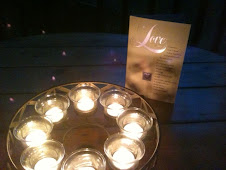The Moving Wall is an exact replica of the Vietnam Veterans Memorial in Washington, DC.
When the Vietnam Veteran's Memorial was originally conceived and planned, it did not receive universal support. Many people found it offensive and ugly. Maya Lin, the winning designer, held fast in her position that it should be executed exactly as designed. One suggestion was to place a three-soldier sculpture in the middle where the two walls met. She was adamant that this would take focus from the wall and place it on the sculpture. (See "Opposition to Design and Compromise"). I am glad she prevailed.
The sculpture of three soldiers was made, but sits off to the side. The Wall in Washington has become one of the most moving and important memorials in history. Within years of its construction, a replica was made that could be taken to communities around the United States. I've been to the real wall, and this fall I went to the Moving Wall. I found both experiences to be memorable. It is a unique memorial.
The design concept is simple. Slabs of granite form a two-sided wall. The list of names of those who died (or are missing) start in the corner where the two walls meet. They continue in chronological order of their death or capture. By each name is a diamond shape. If the person is still missing, the name has a + by it. When that person's remains are found, the + is filled in and becomes the diamond shape. In that way, all who were lost were recognized. (Sadly, there are still many + marks on the wall.) When the engraver came to the end of the west wall, he began at the beginning of the east wall and continued engraving names. The names of the last that died end where the two walls meet in the middle. The concept is that the first man to die was there to greet the last one. It is very powerful.
Coming home from the war in the 60's and 70's was not the jubilant welcome soldiers in WWI and WWII had experienced. Our nation was not only in a military conflict but an internal conflict about that military action. Many soldiers left one war only to come home to another, one they really didn't understand. I am not a historian, veteran, or psychologist so I won't attempt to convey their experience here, but I do remember those days, and they were rough.
It is hard to describe the impact a black granite wall can have, and yet, just walking towards it, seeing all the names engraved, is sobering.
People who wanted to find a name, went to a tent where they could look up the name and locate the numbered granite slab it was on. Watching veterans as they stop, search for a name, and then find it, is touching to say the least. This memorial takes them back to a time they want to forget, but can't.
It has become a tradition for visitors to make a rubbing of names they have found. Some leave mementos.
 |
| "To honor all brothers who gave their all. We can't lay a wreath, but we remember!" |
Veteran's Day was set aside after WWI, considered to be the "War to End All Wars". Sadly, it wasn't. But until it is, may we always remember that every returning warrior needs a heartfelt "Welcome Home".






